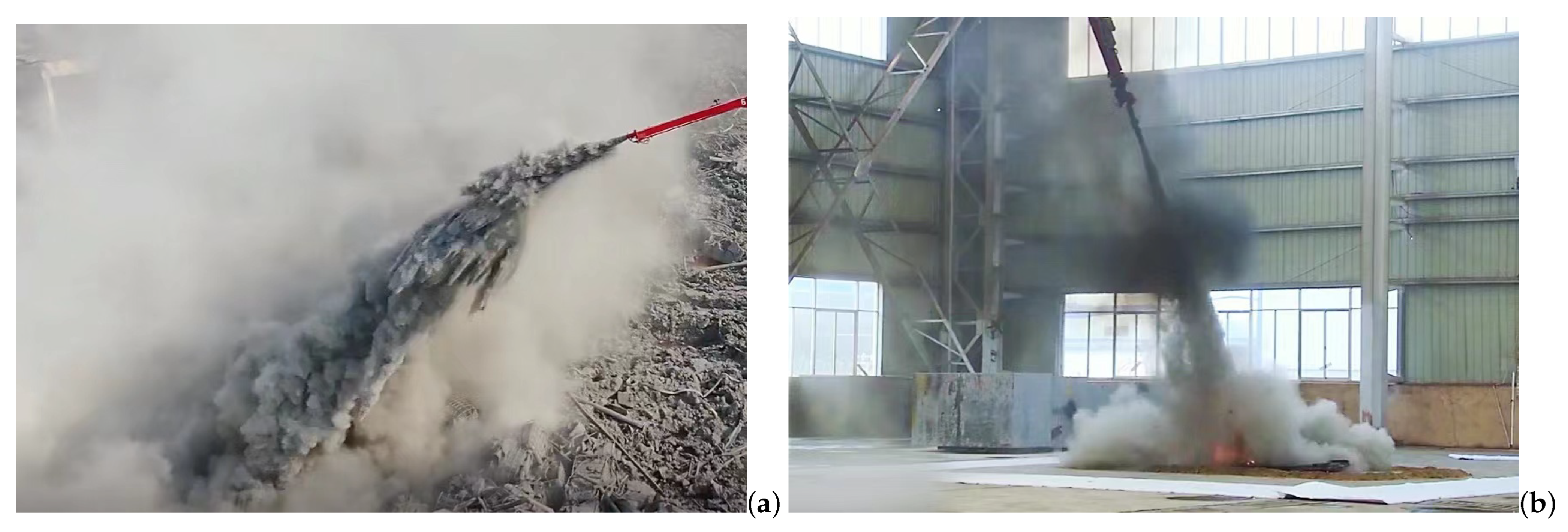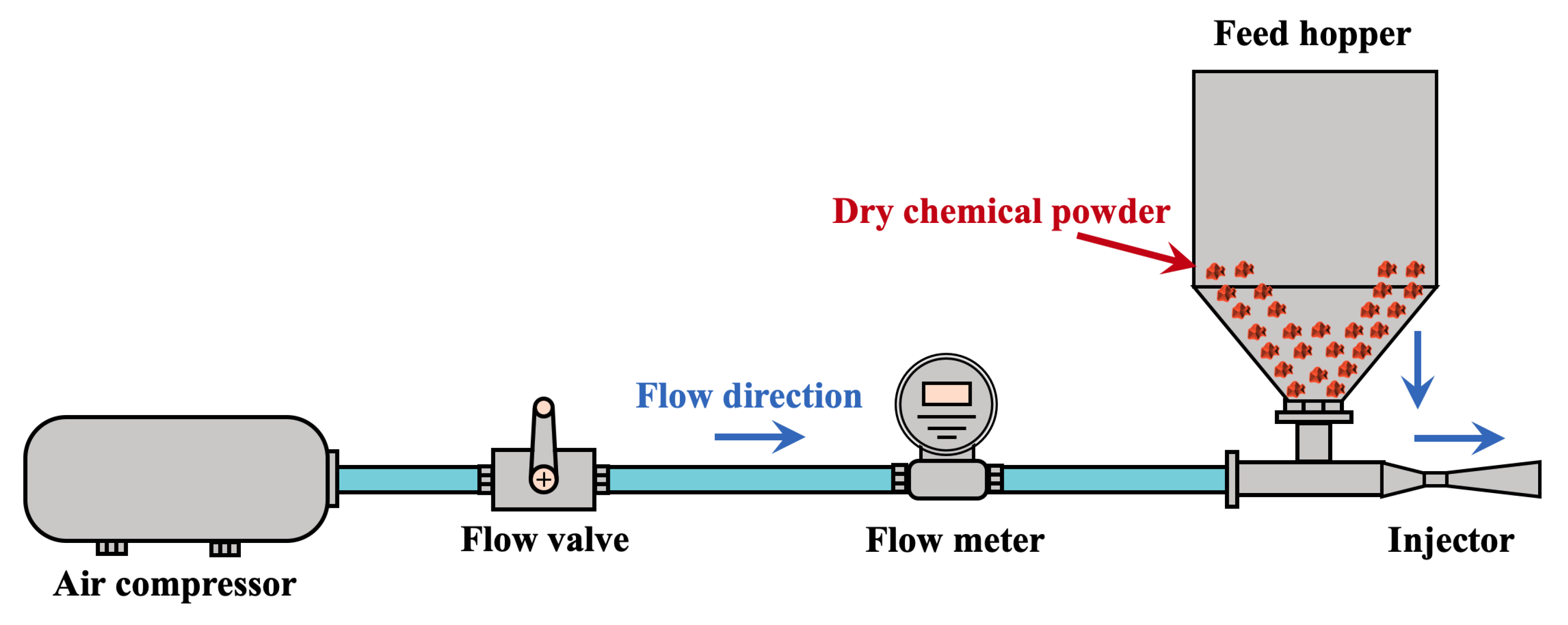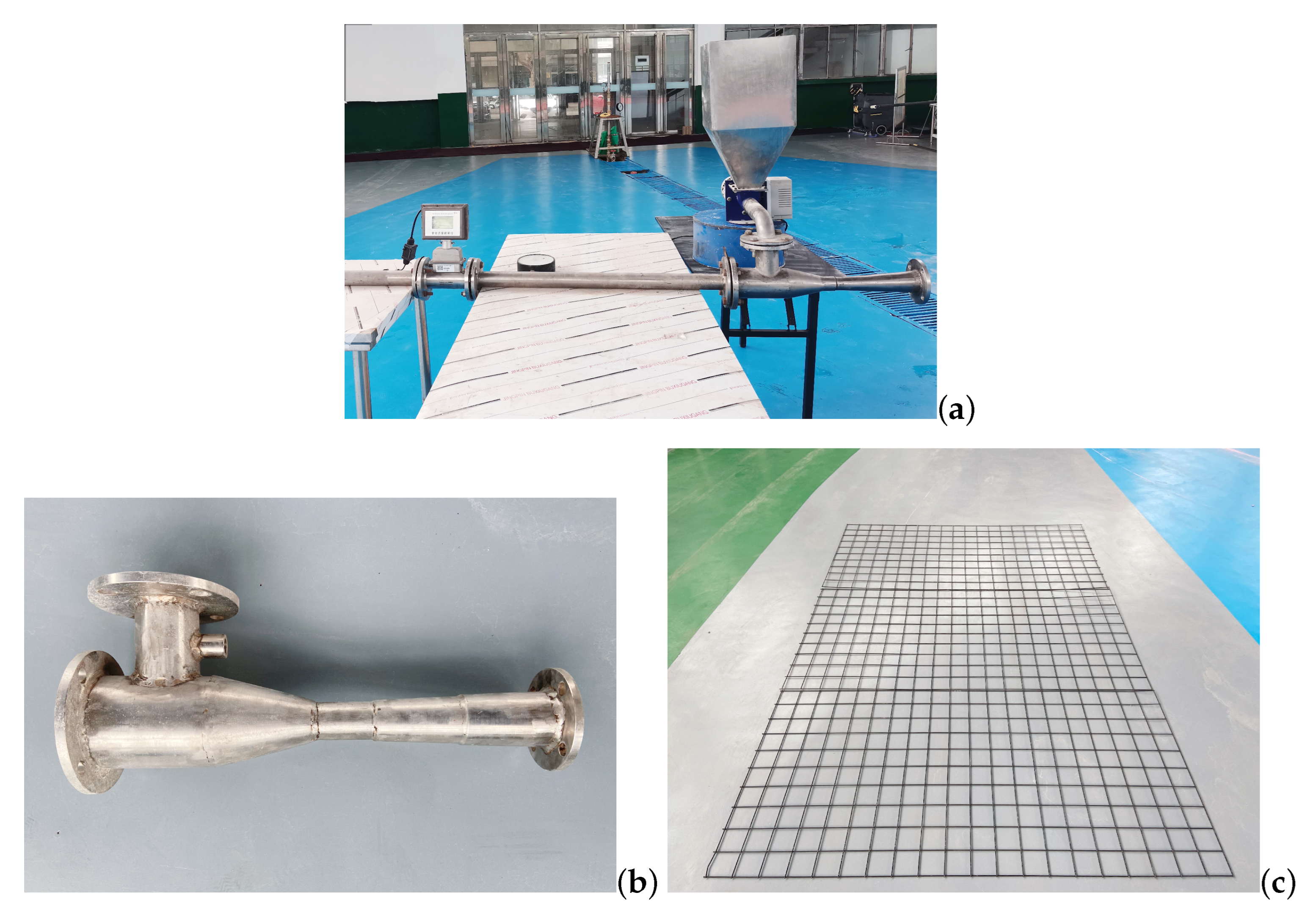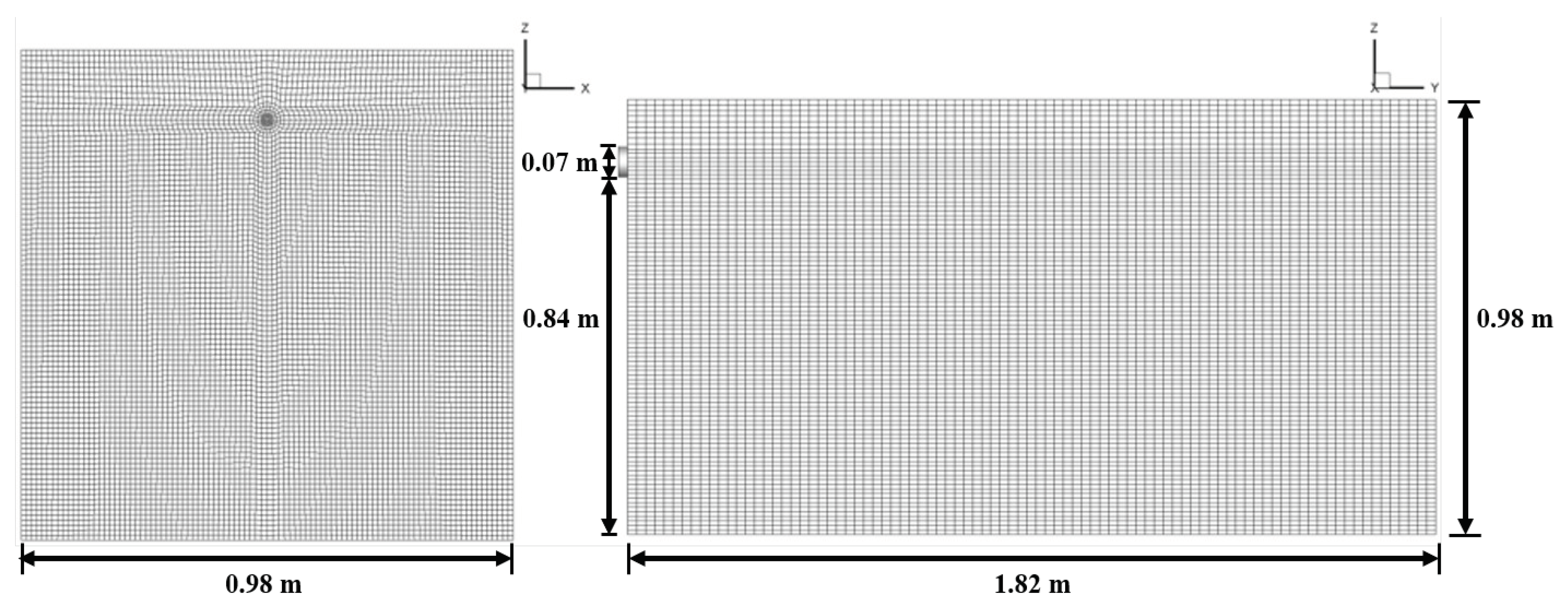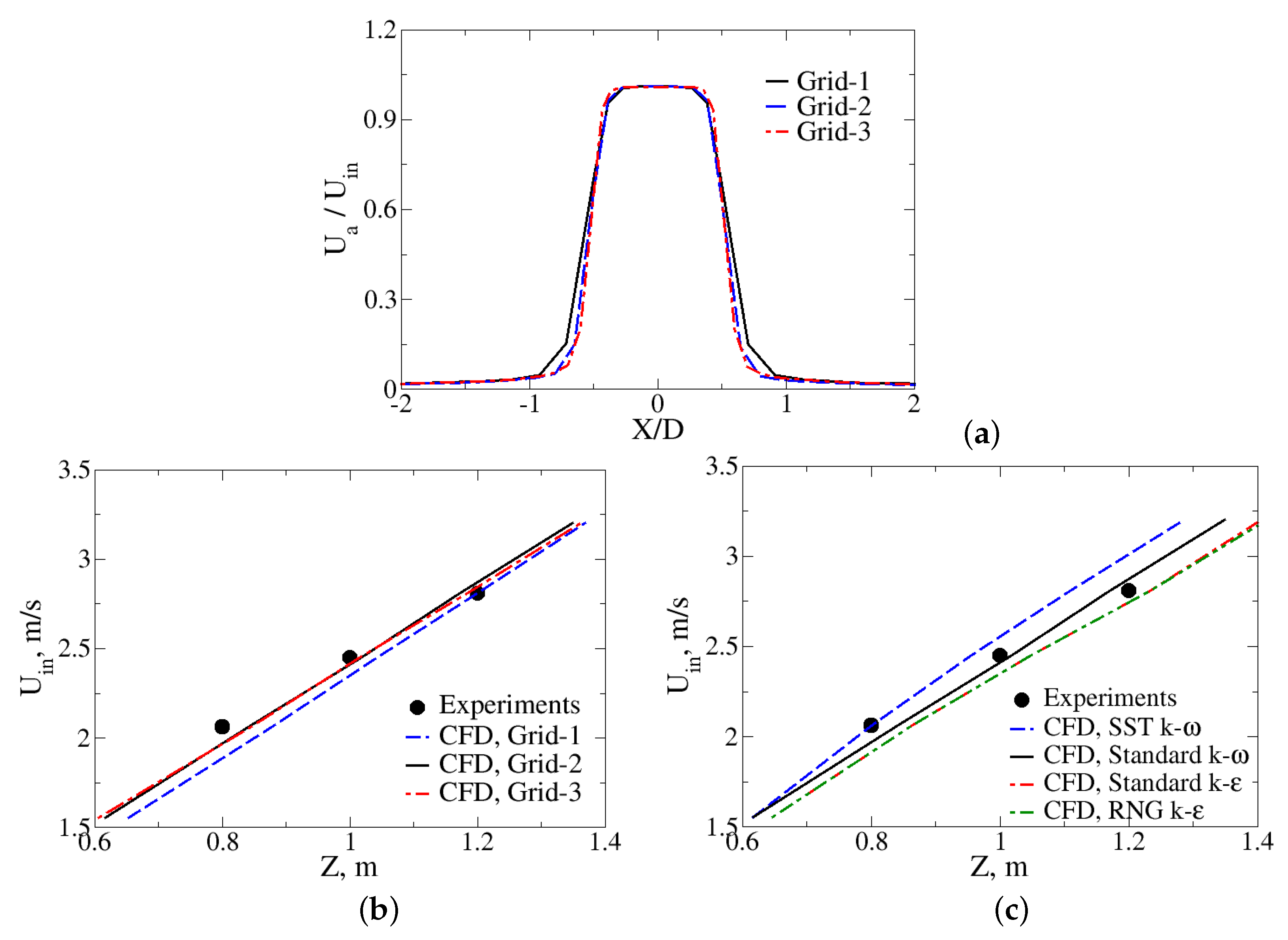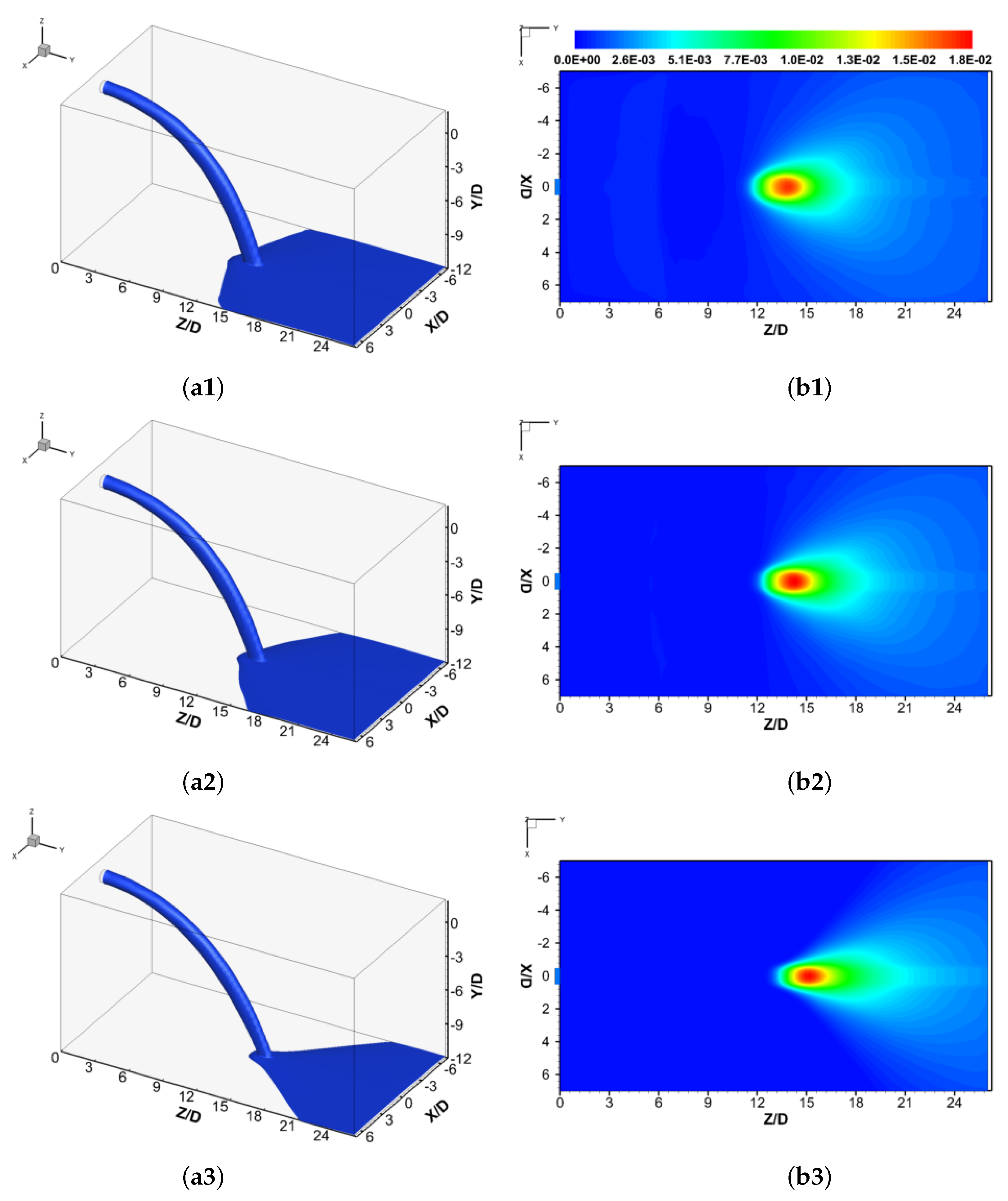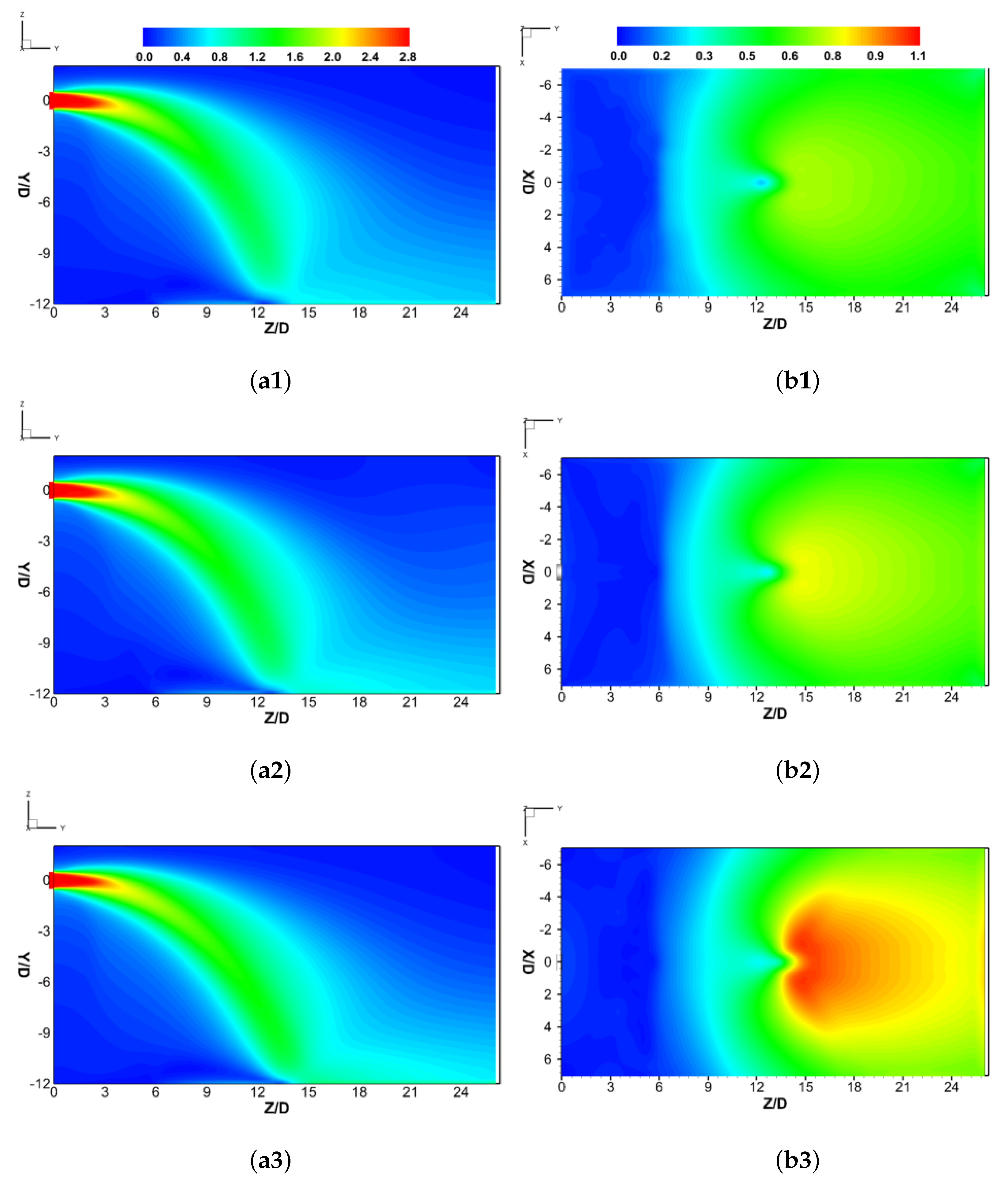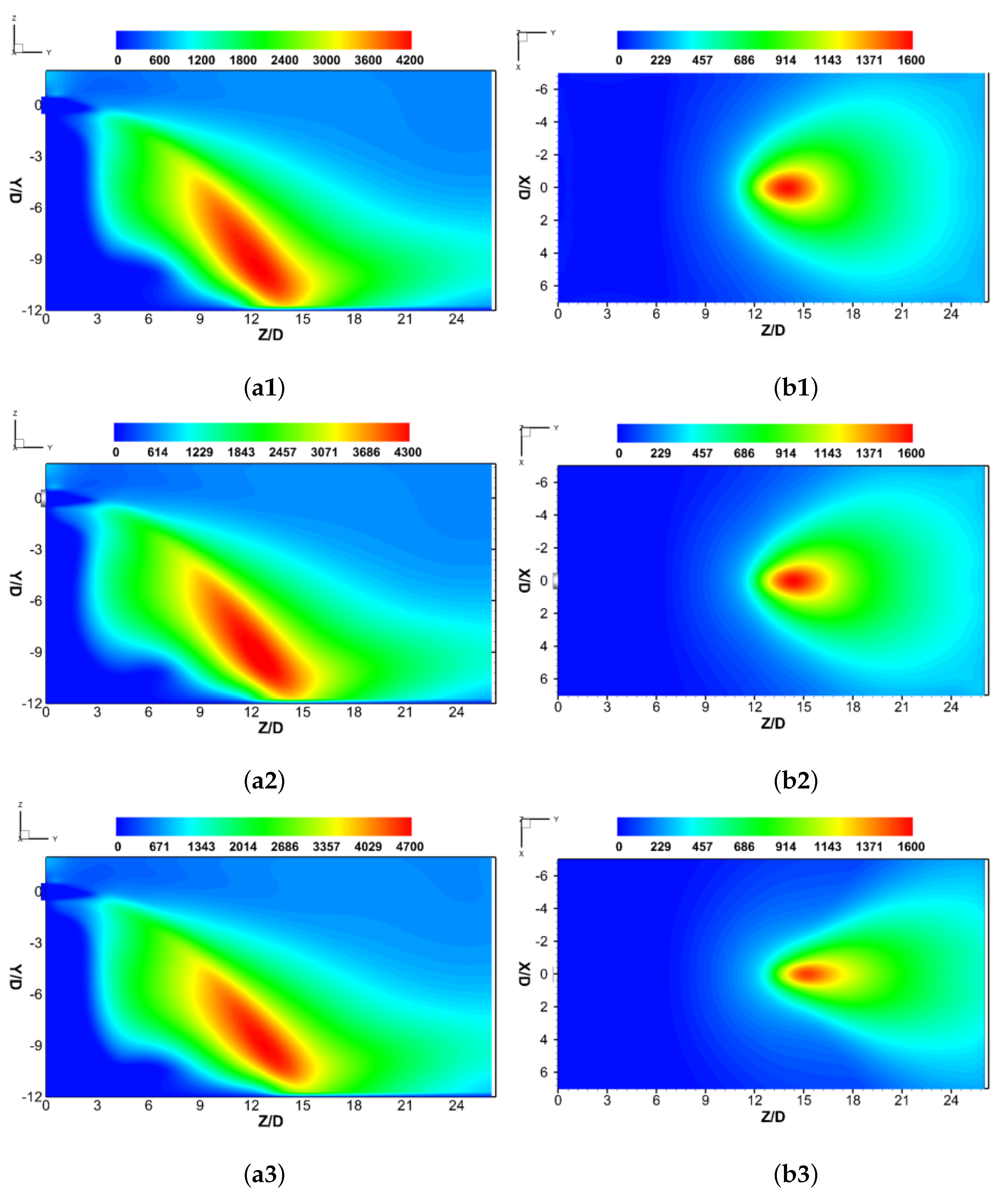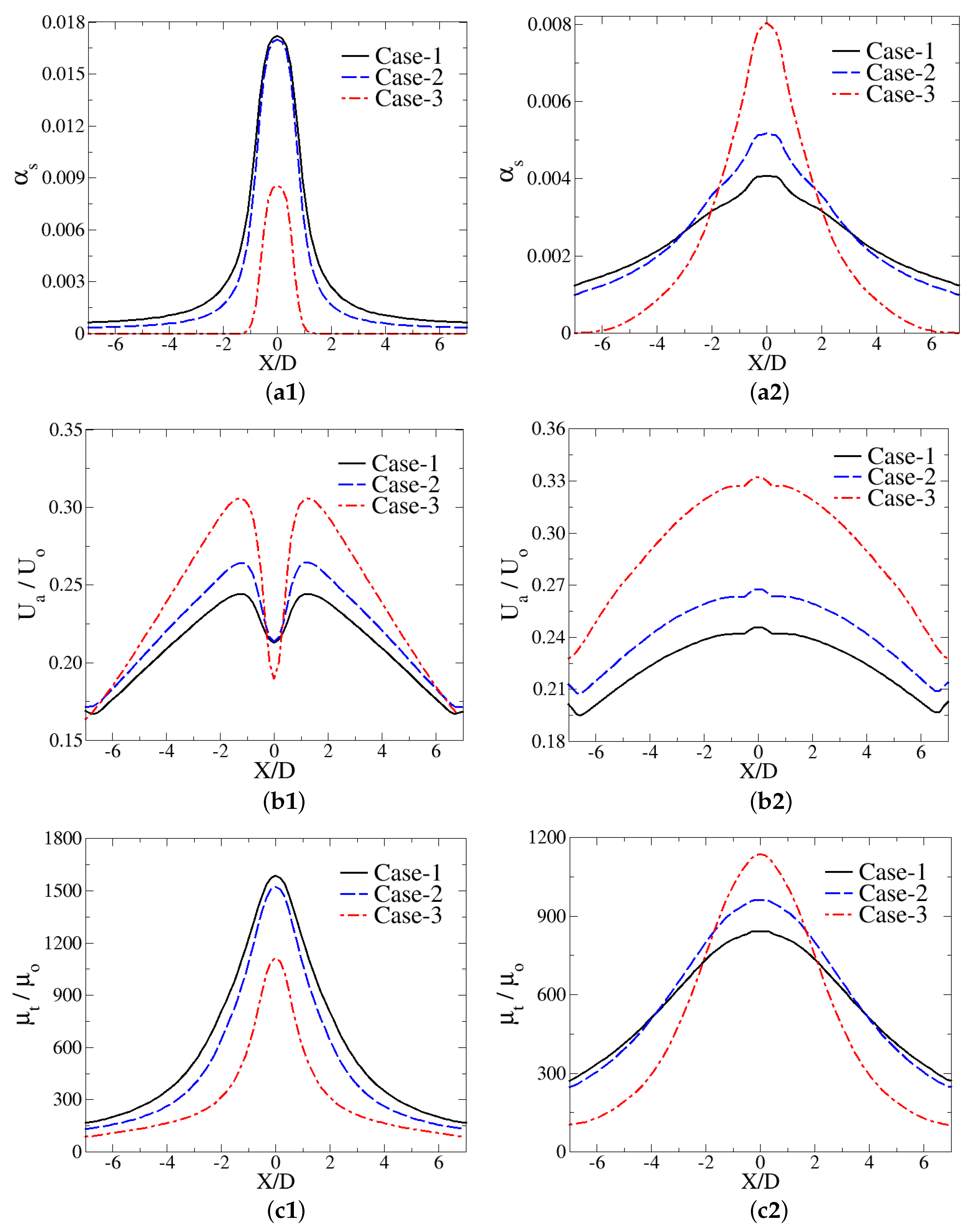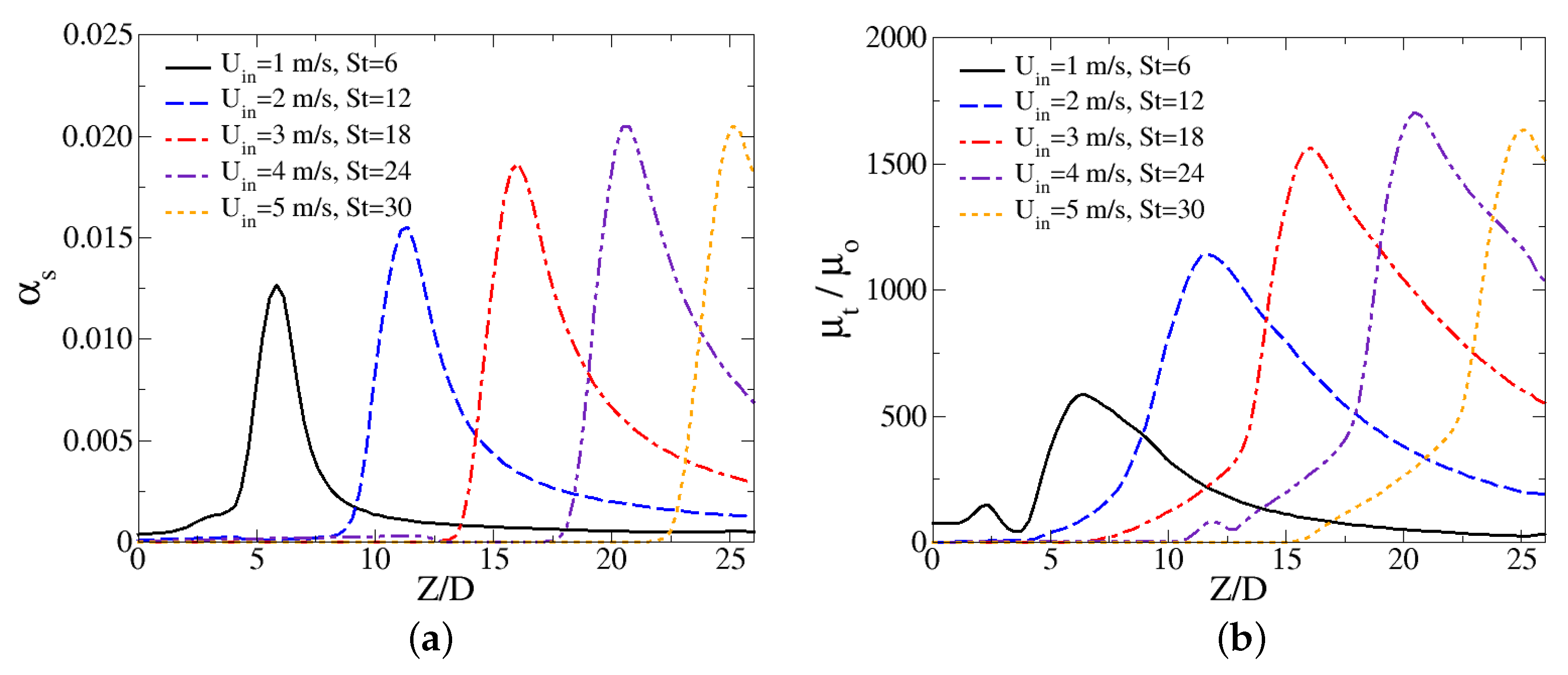1. Introduction
Two-phase particle-laden turbulent jets have been utilized in a broad range of scientific and engineering applications, such as the mining process, pneumatic transport, particulate pollution control, fluidized bed mixing, and fire suppression process in marine industry. Among these involved applications, discharging powders from a injector is often encountered, especially in the fire suppression in a ship under sea condition. Fire and explosion accidents are two common shipping accident types in maritime transportation. It is reported that 29% and 17% of accidents in maritime transportation are caused by fires and explosions, respectively [
1]. The fire and explosion can directly lead to extraordinary damage to people, marine property, and ocean environment. In the fire exhausting process, many fire-extinguishing agents (e.g., water, foam, CO
, dry chemical powder) and equipment (e.g., sprinkler, fire hose nozzle) have been investigated and adopted in a wide range of fire protection fields. Among them, the dry chemical powder fire suppression agent receives much attention owning to its low toxicity, low cost, environmental friendliness, and prominent fire-extinguishing performance for suppressing the emergent fire and explosion emergency in maritime transportation [
2], see
Figure 1. In particular, the fire suppression efficiency of dry chemical powder is almost 40 times that of water and foam, 4 times that of CO
, and 2.3 times that of haloalkanes [
3]. Moreover, the dry chemical powder is the most effective method for extinguishing the liquefied natural gas (LNG) fire and flammable metals during the marine transportation process due to the existence of sodium/potassium bicarbonate. The main principle of the dry chemical powder fire suppression equipment is to cut or restrict the oxygen supply, which is an essential oxidant for combustion from the flammable products through coating the fuel with a thin layer of inert solid. In particular, the powder particles are propelled by carbon dioxide or nitrogen, and then injected from the nozzle to form a mist-like powder steam, which can inhibit the radical chain reaction in the flame zone, thereby suppressing the fire [
4]. Therefore, improving the efficiency of the powder injector, thereby enhancing the fire suppressing performance of dry powders, has become the main object in the marine fire suppression field.
The efficiency of the powder injector is mainly dependent on the powder properties (e.g., size, density, and composition) and the geometry of the injector (e.g., diameter, length, and discharge angle). There has been considerable research into particle-laden jet flow, e.g., see works [
5,
6,
7,
8]. Lau and Nathan [
9] investigated the particle velocity and concentration distributions in a particle-laden turbulent jet though digital particle image velocimetry (PIV). The comprehensive data revealed that the effective Stokes number in the axial direction is lower than that in the radial direction. Kuang et al. [
10] experimentally studied the effectiveness of superfine commercial dry powder in the fire suppression system, and they found that the decreased powder size improves the fire extinguishing effectiveness significantly. Yang et al. [
11] conducted detailed experimental investigations to analyze the influence of the injector structural parameters on the injection performance of the gas–solid two-phases flow. They found that the length of the injector is the most significant parameter, and the curve change of pressure can indicate the particle transportation state. AbdEI-hamid et al. [
12] has conducted a series of experiments to study the air-solid two-phase flows through three different injectors, and the results indicated that the convergent-constant-divergent injector (Venturi-type injector) can enhance the injection performance. Fang et al. [
13] indicated that the granular dispersion fades away with the increase of the injector wall thickness.
The computational fluid dynamics (CFD) has been widely accepted as an excellent tool to describe the powder jet characteristics, with numerous applications ranging from chemical to marine industry [
14,
15,
16,
17]. Jebakumar and Abraham [
18] carried out two-dimensional (2D) axisymmetric CFD simulations using a k-
turbulence model to analyze the structure of particle-laden jets for Stokes number = 0.3 to 500. They found that the jet structure is sensitive to the gas phase turbulence intensity at low Stokes number, while the jet structure is sensitive to the inlet particle velocity fluctuations at high Stokes number. Tavangar et al. [
19] used a three-dimensional (3D) Eulerian–Lagrangian multiphase model coupled with k-
shear stress transport (SST) turbulence model to investigate the horizontal motion of particle-laden jets and analyzed the relations between the jet Reynolds number and Stokes number. Patro et al. [
20] presented the results of a numerical analysis of the Eulerian–Eulerian multiphase model of the gas–solid free jet flow in vertical downward direction, and they reported that the smaller particles can attenuate turbulence while the large particles enhance turbulence. Zhang et al. [
21] investigated jet-to-coflow velocity ratio on the particle-laden coflow jet characteristics using large eddy simulations (LES) approach. The particles are mainly distributed in the center region and less concentrated outside the jet edge under the effect of small jet-to-coflow velocity ratio. Zhang et al. [
22] conducted a experimental and numerical study of particle dispersion in a coaxial jet flow, and the particle shape effect has been found less sensitive compared with the size distribution effect on the particle dispersion.
The dry powder fire extinguishing device can be classified as fixed type and portable type according to the specific applications. Most previous studies focus on the fire suppression performance in the internal environment (e.g., factory and laboratory), where a powder nozzle is vertically located on the top wall, and the vertical jet of powder coming out of a nozzle for maximum coverage in a closed area. However, in the marine transportation process, the remote powder fire extinguishing device is more favorable since the portable powder jet nozzle can flexibly extinguish the fire in the external environment (e.g., outside container) and the remaining fire at the blind spot on the board ship.
Through the literature review, it was found that there is a great deal of work aimed at increasing the efficiency of the fixed-type dry powder fire extinguishing device and consequently enhancing the fire suppression performance, either by focusing on the operating conditions, or by the design and study of the device structures. However, there are limited works on the comparative investigation of the discharge performance of portable-type powder fire extinguishing device for different powder agents. Ibrahim et al. [
23] experimentally studied the effectiveness of three different commercial dry powders in the portable-type fire suppression system, and they found that the milled Mg(OH)
powder shows a better fire extinguishing effectiveness than ABC dry powder and NaHCO
powder. Liu et al. [
3] conducted a bench-scale experiment to evaluate the performance of three fire suppression agents: Mg(OH)
powder, NaHCO
powder, and NH
H
PO
powder, and they found that the fire extinguishing times of Mg(OH)
powder are much shorter than others powders. However, we note that these works only evaluate the performance of different fire suppression agents through experiments, the behavior and characteristics of the particle-laden jet flow with different fire suppression agents have not been comprehensively investigated, which has to be modeled using advanced mathematical models implemented into CFD software.
Motivated by a lack of solid comparison of 3D simulations results to experimental data, the aim of the present study is to investigate the flow characteristics of the particle-laden turbulent flow from a horizontal injector into the free-stream domain for a wide range of Stokes numbers by considering the effect of gravitational acceleration. Both experimental and numerical studies are compared to enhance the validity of the present research work. Two performance indexes of the discharging process, namely solid discharge range and solid dispersion concentration, are adopted to evaluate the performance of three different powder agents, ABC dry powder, BC dry powder, and Portland cement powder, under various operating conditions. Through the experimental test and numerical simulation, the gas–solid flow characteristics and powder trajectory are revealed, which can provide a reference for the optimization of this particle-laden turbulent flow system.
The rest of the work is organized as follows. The next two sections provide an overview of the experimental setup and the specific numerical methodology. This is then followed by grid-independent test and validation where the computed results are compared with the experimental data. Subsequently, the detailed results and discussion are presented. Finally, the main conclusions are given.
2. Experimental Apparatus and Condition
A schematic representation of the powder pneumatic injection system is shown in
Figure 2. The setup consists in a feed hopper, an air compressor, a control valve, a electromagnetic flowmeter, a conveying line, and a gas–solid injector. A stainless steel conical hopper of 50 L capacity is used to hold the tested particles, and the feed speed (up to 2 kg/min) is controlled by the hopper valve. The tested powder is ABC dry powder (NH
H
PO
> 90%), which was purchased commercially from Longxin Fire Equipment Manufacturing Co., Ltd., Zhejiang China. The commercial powders were not filtered before experimental study. The commercial particle size range measured by Mastersizer 3000 laser diffraction analyzer is from 0.4 to 1000 μm, and the medium diameter (
) is 24 μm.
An air supply compressor (FBW-1.6/8, Shanghai Jiebao Compressor Manufacturing Co., Ltd., Shanghai, China) with a maximum capacity of 11 KW at ambient temperature was selected to produce air flow into the transportation section. A stainless steel pipe with an inner diameter of 50 mm and a total length of 4.3 m was used as the delivering line, which was located at a 0.84 m height. The total of 2 kg ABC dry powder was stored in the feed hopper (A011, Xinchanglong Machinery Manufacturing Co., Ltd., China) located roughly 0.5 m apart from the injector during the tests, as shown in
Figure 3. After passing through the delivering line with control valve, the gas–solid two-phase flow was sufficiently mixed and accelerated in the straight pipe with 580 mm length. In the present study, the Venturi type injector is chosen to study the particle-laden jet flow. The main advantages of using Venturi type injector are a high level of mixing efficiency, low energy requirement, and short mixing length [
24,
25]. The fully mixed solid–gas flow is beneficial to the fire extinguishing performance.
For the measurements, the air flow rate, Q, is measured in the delivering pipe using a flow meter (WQB-50, Best Instruments Co., Ltd., China) with an accuracy of ±3% FS. The particles are transported into the injector through the feeding system with a fixed solid mass flow rate of 2 kg/min. A total of 200 transparent plastic containers (10 cm × 10 cm square) were placed within the particle dispersion area to collect the dispersed particles. The particle collecting area is over 3.38 m (2.6 m in the discharge direction and 1.3 m in the cross direction). The particle landing position was determined by measuring the mass of each container.
The air moisture has an effect on the flowability of the powder jet flow. A higher level of air moisture will increase the thickness of the adsorbed liquid layer, which enhances the strength of liquid bridges. As a result, the gas–solid flow becomes more cohesive and tends to form agglomeration. The solid discharge range and solid dispersion concentration will be affected as well. Most studies observed a decrease in flowability of the powder jet flow with the increase of air moisture [
26,
27,
28]. In the present study, the experiments were carried out in the experimental laboratory with an averaged humidity of 70%. Further studies will be carried out to investigate the influence of air moisture on the discharge performance of particle-laden jet.
4. Grid Dependence Analysis and Validation of Numerical Simulation
In the present case, we simulated the particle-laden flow in a horizontal direction by considering the effect of gravitational acceleration. Cases of three different grid resolutions (260,092, 793,244, and 2,445,465 cells) are conducted to seek a mesh-independent solution. The radial variation of the normalized air velocity,
/
at
= 3 and
= 0 is presented in
Figure 5a. It can be seen that the air velocity distribution is a “n-shaped” structure, with a maximum (
/
= 1) close to the center of the powder jet and a minimum (
/
= 0) towards the edge of the jet. Case of 260,092 cells shows a higher air velocity profile than cases of 793,244 and 2,445,465 cells in the center and edge jet joint region, but no apparent difference of the cases of 793,244 and 2,445,465 cells is observed in the axial distributions of the normalized air velocity.
To further ensure the reliability of the numerical model, simulations were performed for comparisons with the measurements of the powder landing position in a 3D particle-laden jet flow.
Figure 5b shows the comparison of simulated and experimental powder landing positions under different inlet flow velocities. It should be noted that the experimental study of free powder jet flow is rare from the literature, and the experimental data generated from the present study is not comprehensive enough for an exhaustive evaluation of CFD tools performance. This is mainly due to the limited feed capacity of the feed hopper. The maximum feed capacity of the adopted feed hopper is 2 kg/min, and the dilute dispersion of particle in air can be observed once the feed capacity is lower than 2 kg/min. Therefore, we performed experimental study for the three different inflow velocities (2.06 m/s, 2.45 m/s, and 2.81 m/s) with a maximum particle feeding rate of 2 kg/min to investigate the performance of particle-laden jet. It is observed that the simulated results under three different grids exhibit similar trends in terms of particle landing positions. Clearly, the particle landing distance increases from 0.6 m to 1.4 m as the inlet flow velocity increases from 1.55 m/s to 2.94 m/s. Moreover, Grid-1 underpredicts the inlet flow velocity in most conditions, with a deviation of 8.64%, while Grid-2 and Grid-3 show good agreement with experimental data, with deviations of 3.71% and 2.46%, respectively. Therefore, Grid-2 with 793,244 cells is used in the numerical prediction for free powder jet flow to guarantee a satisfactory degree of computational accuracy.
The main purpose of the model validation is to ensure the global formulations, meaning a set of submodels (e.g., turbulence model) is able to predict the discharge performance under various flow conditions. Four different RANS turbulence models were tested: the Standard
k-
, the Standard
k-
, the RNG
k-
, and the SST
k-
. As can be seen from
Figure 5c, the predicted particle landing profile illustrates that there is no apparent difference of the results calculated from Standard
k-
turbulence model and RNG
k-
turbulence model. In comparison, greater difference could be seen in the landing positions for the SST
k-
and the Standard
k-
model. In particular, the predicted results from the Standard
k-
model agree well with the experimental data, with an averaged deviation of 3.71%, whereas the SST
k-
model underpredicts the particle landing position for
> 2 m/s, with an averaged deviation of 12.69%. The results suggest that the Standard
k-
dispersed turbulence model is more accurate at predicting free powder jet flows than other turbulence models.
5. Results and Discussion
To unify the results from the computations, two dimensionless parameters, the Reynolds number,
, and the Stokes number,
, are applied to understand the hydrodynamic characteristics of the particle-laden jet flow. By definition, the Reynolds number
is the ratio of inertial forces to viscous forces, and the Stokes number
expresses the relationship between the particle relaxation time and the fluid characteristic time. The Reynolds number and Stokes number are calculated as follows:
where
and
are the density of particle and air, respectively.
D is the diameter of the injector,
is the diameter of particle,
is the inlet flow velocity, and
is the viscosity of air. In particular, a small Stokes number (
≤ 1) represents that the solid particles will mostly follow the fluid motion acting like a tracer, while a larger Stokes number (
≥ 1) means that the solid particles are not tightly coupled with the fluid. In the free jet region, the particle Stokes number will affect the behavior and performance of the turbulent particle-laden jet flow significantly. In the present study, different cases are considered (summary in
Table 1) to investigate the influence of Stokes number and Reynolds number on the dispersion performance of a particle-laden jet.
To characterize the turbulent particle-laden flow characteristics for ABC dry powder (Case-1), BC dry powder (Case-2), and Portland cement powder (Case-3),
Figure 6,
Figure 7 and
Figure 8 show predicted results gained by means of the 3D Eulerian–Eulerian multiphase model coupled with Standard
k-
dispersed turbulence model at
= 13,466. All particles have a uniform diameter of 200 μm, but different densities in the range between 1800 kg/m
and 3340 kg/m
. The solid concentration is set as 0.2%. From the figure, the iso-surface contour plot of the solid volume fraction,
= 0.001, is used to visualize the distribution of the solid particles in the computational domain. As can be seen from
Figure 6a, the solid particles are discharged from the injector exit and then travel a certain distance in the air. After that, the solid particles fall down and land on the ground due to the gravitational force, and finally spread toward downstream. Clearly, the similar shape of the trajectories predicted from three different powder agents can be observed, but the distribution of the solid particles on the ground is significantly different. In particular, the solid dispersion concentration is converted from U-shaped for Case-1 to V-shaped structure for Case-3 in the dispersion region.
To further explore the influence of powder agents on the particle concentration distributions,
Figure 6b shows contours of solid volume fraction on the ground. As can be seen from the figure, a wide range of solid volume fractions (0–0.18) are distributed on the ground for three different cases. Higher solid concentration is mainly distributed at the landing position, with a maximum value of 0.018, while a lower solid concentration exists downstream of the landing position. The total dimensionless coverage area is
= 50%, 42%, and 35%, while the highest concentration (
≥ 0.017) coverage area is
= 0.15%, 0.21%, and 0.24% for ABC dry powder (Case-1), BC dry powder (Case-2), and Portland cement powder (Case-3), respectively. It is noted that the total coverage area decreases significantly by 15%, while the highest concentration coverage area increases slightly by 0.09% as the particle density increases from 1800 to 3340 kg/m
. Comparing the results from Case-1, Case-2, and Case-3 shows that the particle landing position moves downstream from
= 13.5 to
= 15.3 (about 12%), which suggests that the Portland cement powder has a greater ability to travel a longer distance than the ABC dry powder and BC dry powder. This is mainly due to the effect of Stokes number. As the Stokes number increases from 9 (Case-1) to 17 (Case-3), the particle-laden flow is controlled by the inertial force and has a poor followability. Hence, the particle landing position is more likely to move downstream with the increase of Stokes number. Additionally, solid particles with small Stokes number are more likely to be entrained by vortex clusters and therefore enhance the radial dispersion on the ground.
Figure 7 displays the slices of a 3D contour plot of air velocity magnitude in the middle Y-Z plane and close to the ground wall (
= −11.9) at
= 13,466. The red color denotes the maximum value of velocity magnitude, whereas the blue color represents the minimum value of zero. The momentum and the gravity-induced instabilities affect the velocity distribution of the free powder jet. As can be seen from
Figure 7a, the powder jet is developed near the outlet of the injector for a certain distance before gravitational forces takes over and causes the jet drops down toward the ground. A similar distribution of the velocity pattern can be observed for all cases in the middle of the Y-Z plane. In particular, the higher velocity zone exists behind the discharge position, while the velocity magnitude decreases significantly from 2.8 to 0.8 m/s as the powder jet widely spreads to the surrounding from the outlet of the injector. Moreover, it becomes apparent that the high velocity magnitude zone (
> 0.8) enlarges greatly toward the downstream close to the ground wall with the increase of the particle density from 1800 to 3340 kg/m
, see
Figure 7b. This indicates that the influence of small change of particle density can result in large variations in the velocity field near the ground wall. The larger particle density, the intense inertia of particles, the higher velocity magnitude. On the other hand, the stagnation point can be identified at the particle landing position where the stagnation velocity is close to zero and the static pressure is at its maximum value from the Bernoulli equation.
Figure 8 shows the contour plots of the turbulent viscosity ratio
in the computational domain with different powder agents. The turbulent viscosity ratio, which is defined as the relation between the turbulent viscosity
and molecular viscosity
, is utilized to evaluate the magnitude of turbulence within the 3D simulations [
15]. As illustrated in
Figure 8a, all three cases exhibit a similar distribution of turbulent viscosity ratio in the middle of the Y-Z plane. However, the maximum magnitude of
increases from 4200 to 4700 as the particle density increases from 1800 to 3340 kg/m
, which indicates that the higher Stokes number can enhance the turbulence intensity in the turbulent regime significantly, and also lead to a strong dispersion behavior of solid particle in the axial direction. On the other hand,
Figure 8b depicts the spread of turbulent viscosity ratio near the ground at
= −11.9, which is consistent with the distribution of solid volume fraction on the ground shown in
Figure 6b. The turbulence viscosity is clearly seen to have a dominant influence on the structure of the particle concentration distribution. The oval-shaped intense turbulence area (
> 1300), which is mainly concentrated near the particle landing position for all cases, shrinks significantly by 50% from Case-1 to Case-3. Additionally, the magnitude of turbulent viscosity ratio declines greatly along the edge of the powder jet in the region between
= 12 to 21 as the particle density increases from 1800 to 3340 kg/m
. This phenomenon is expected since the heavy particles lead to a reduction of turbulence kinetic level and a decrease of the momentum exchange in the radial direction, especially near the jet edge. Thus, more solid particles are concentrated on the central area, thereby forming a V-shaped structure of solid distribution close to the ground wall.
Figure 9a shows the radial distribution of the solid volume fraction for various particle agents. The solid volume fraction is larger in the central region and less in the jet edge at both positions. When compared to the solid volume fraction predicted at
= 14, the spreading increases radially, and consequently more solid particles agglomerate near the edge of the jet at
= 18. The ABC dry powder (Case-1) and BC dry powder (Case-2) give a highest solid concentration at
= 14, while more Portland cement powder (Case-3) is accumulated in the same central region at
= 18, which further confirms that the Portland cement powder has a greater ability to be discharged in a farther location than the ABC dry powder and BC dry powder.
A distinct change in the shape of the normalized air velocity profile can be observed in
Figure 9b as the axial position moves from
= 14 to 18. It should be noted that the stagnation point is present in the center region (
= −1 to 1), as shown in
Figure 9(b1), where the local velocity is significantly lower. Furthermore, it can be seen from
Figure 9(b2) that the velocity fluctuation is more steady with the decrease of Stokes number from 17 (Case-3) to 9 (Case-1) at
= 18. This is though to be primarily due to the fact that the momentum exchange between the jet and the surrounding air is much higher for dense powder flow with a less steep velocity profile.
Figure 9c presents the distribution of turbulent viscosity ratio at various axial locations for different cases. Based on the comparison results displayed in
Figure 9(c1), Case-1 shows a higher magnitude of turbulent viscosity ratio across the
axis as compared to Case-2 and Case-3. However, as the powder flow disperses to the downstream, the radial dispersion of turbulence viscosity ratio is reduced significantly about 62% at the jet edge, while that increases by 34% at the center region. The decrease of turbulent viscosity ratio causes reduction in mixing, and the spreading of powder jet becomes narrower in the radial direction.
We further evaluated the discharge performance of Portland cement powder under various operating conditions. The axial distribution of solid volume fraction profile at
= 11.9 and
= 0 is present in
Figure 10a. Five different inflow velocities,
=1, 2, 3, 4, 5 m/s, are imparted at the entrance of the injector, corresponding to
= 6, 12, 18, 24, 30, and
= 73,647, 36,824, 24,550, 18,412, 14,730, respectively. As can be seen from the profile, a noticeable narrow peak in the solid volume fraction profile is captured for all cases. This peak corresponds to the particle landing position. It is seen that the particle landing position moves from
= 5.8 to
= 25.1 as the inlet velocity increases from 1 to 5 m/s. This is due to an increase in jet momentum, while the gravitational force is not strong enough to cause a lower deviation of the jet. Additionally, we found that the solid volume fraction increases by approximately 61% with the increase from inlet velocity, which suggests that more solid particles are concentrated in the particle landing positions at higher Stokes number.
Figure 10b illustrates the axial distribution of turbulent viscosity ratio profile under the same operating conditions. It is clearly seen that the maximum value of
increases by about 180% with the increase of inlet flow velocity from 1 to 5 m/s. This phenomenon indicates that the high level of turbulence intensity enhances the solid dispersion concentration on the particle landing position.
